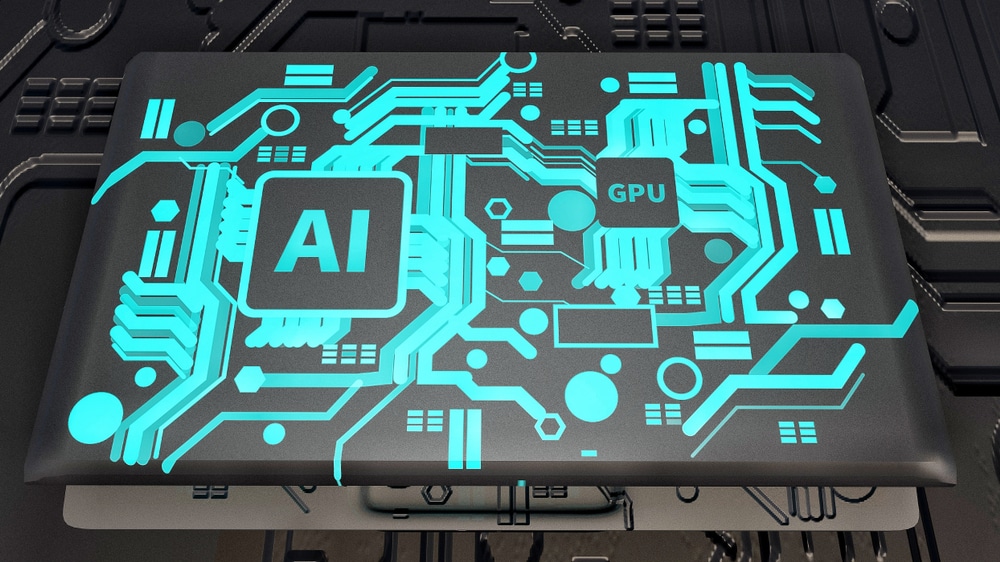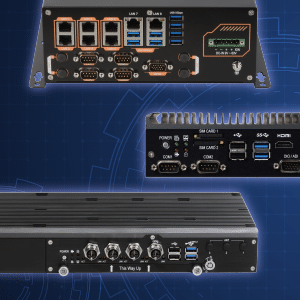What Is Edge GPU and How Does It Work at AI Edge Application?
“Edge GPU” typically refers to a GPU (Graphics Processing Unit) that is used in Edge computing, which involves processing data at the Edge of the network, closer to the source of the data. Edge computing is used to improve the speed and efficiency of data processing, by reducing the amount of data that needs to be transmitted to the cloud or data center for processing. Edge GPU is a vital component of smart things; it helps move AI computational power to the Edge of the network, where the data is located. Streamlining and improving services and operations may be accomplished by leveraging a huge amount of the data generated by the Internet of Things (IoT) sensors and then creating insights from that data.
Continue reading to learn more about GPUs, how they may be used as hardware for artificial intelligence, the advantages and solutions that can be achieved via Edge computing using GPUs (Edge GPU), and how they are driving innovation in AI applications at the Edge.

What Is a Graphics Processing Unit (GPU)?
GPU stands for graphics processing unit. In recent years it has risen rapidly as a crucial component of personal and enterprise computers. The GPU is a special kind of computer chip designed originally for image processing. A GPU contains more computing cores than a CPU. These cores enable parallel computing by dividing a task into multiple smaller tasks and allocating them to different cores to speed up processing. The initial purpose of GPUs was to speed up the display of 3D visuals. As time went on, they evolved to become more adaptable and programmable, thus expanding their range of use. With a GPU, graphics programmers were able to include more sophisticated lighting and shadowing algorithms in their work, resulting in more engaging visual effects and photo-realistic environments.
Due to its parallel computing architecture and excellent image processing capabilities, the GPU is now used in various contexts that require large data or image processing. Current and emerging applications of GPUs include crypto mining, machine learning, deep learning, and other segments in the field of high-performance computing (HPC).
CPU vs. GPU: What’s the Difference?
Below we have compared central processing units (CPUs) with graphics processing units (GPUs):
- Purpose: A CPU is the primary processor in a computer that carries out the instructions of a computer program. It is responsible for performing basic arithmetic, logical, and input/output operations. A GPU is a particularized processor designed to accelerate the creation, manipulation, and rendering of images, video, and other graphics.
- Role: The CPU is the computer’s brain that handles general-purpose tasks, and the GPU is a specialized processor designed to handle graphics and video tasks.
- Architecture: A CPU is optimized for sequential computing, meaning it can execute one main instruction at a time. In contrast, a GPU is optimized for parallel computing, meaning it breaks down tasks into smaller and often similar tasks and executes them simultaneously. This makes a GPU much faster at performing certain types of calculations, such as those needed for 3D rendering, image processing, and machine learning.
- Cores: A CPU typically has a limited number of cores (2-8) with intricate designs for handling complex calculations. In contrast, a GPU is equipped with hundreds even up to thousands of simple cores that are optimized for parallel processing.
An Edge GPU is typically a smaller, more power-efficient version of a traditional GPU, designed for use in devices that have limited space, power, and cooling capabilities. They are used in a wide range of applications, including autonomous vehicles, drones, smart cameras, and other Internet of Things (IoT) devices that require real-time processing of large amounts of data.
GPUs as Artificial Intelligence Hardware
Machine learning is a complex process whereby a computer program is trained to learn from data without being explicitly programmed. The process involves several stages, including dataset collection and preparation, model selection, training, testing, and deployment.
- In the initial stage, a dataset is collected and prepared for training the machine learning model. This dataset contains examples of the problem the model is trying to solve, such as images and corresponding labels indicating what the image represents, in the case of image classification.
- Next, an appropriate machine-learning model is selected for the problem. There are several types of models, such as supervised learning, unsupervised learning, and reinforcement learning, each suited to a specific type of problem.
- Once the model is selected, the machine learning process begins with the training of the model on the dataset. This stage involves adjusting the model’s parameters to predict the output based on the input as accurately as possible.
- After the training session completes, the model is tested on a separate dataset to evaluate its performance. The test dataset should contain examples the model has not seen during training, and performance is measured using metrics such as accuracy, precision, and recall.
- If the model performs well on the test dataset, it can be deployed in real-world scenarios. The entire process requires significant image processing, making GPUs an essential component of machine learning.

When it comes to artificial intelligence technology, GPUs have many benefits, the most notable of which are speed and reduced bandwidth costs.
- Some benchmarks have shown that GPUs may be as much as 200 times quicker than a central processing unit.
- By processing data as close to its source as possible, edge computing lowers the bandwidth and storage costs demanded by data transmission to the cloud.
Edge Computing Benefits and Solutions through GPUs
Edge computing is a form of distributed computing that brings computing power and data storage closer to the network’s Edge, where data is generated. This allows for faster processing and analysis of data, as well as reduced latency and improved security.
One solution to enable Edge computing is using GPUs (Edge GPU). Edge computing benefits and solutions through the use of GPUs can significantly improve the efficiency and effectiveness of various industries, including Industry 4.0, Robotics and Autonomous Vehicles, and Energy and Utilities.
1. Industry 4.0
Edge GPUs are increasingly being used in industrial applications to improve the efficiency, speed, and accuracy of data processing and analysis. By processing data at the Edge, companies can quickly identify and address any issues that arise in the manufacturing process, such as defective products or inefficiencies in the supply chain. Below are some examples of how Edge GPUs are being used in industrial applications:
- Predictive Maintenance: Edge GPUs can be used to process data from sensors in industrial equipment to detect anomalies, predict failures, and schedule maintenance. By using Edge computing, companies can reduce latency and processing time, and avoid the costs associated with sending large amounts of data to a central cloud server for analysis.
- Quality Control: Edge GPUs can be used to analyze images and videos from cameras on production lines to detect defects and anomalies in real-time. This allows companies to catch quality issues early and improve product consistency and customer satisfaction.
- Supply Chain Optimization: Edge GPUs can be used to process data from sensors and other sources to optimize logistics and supply chain operations. By analyzing data on inventory levels, transportation routes, and delivery times in real-time, companies can reduce costs, improve efficiency, and enhance customer satisfaction.
2. Robotics and Autonomous Vehicles
Edge GPUs can be used to process sensor data and control the movements of autonomous robots in industrial settings. By processing data at the Edge, robots and vehicles can make decisions and take action in real time without communicating with a centralized server. This can improve the responsiveness and safety of these systems. This allows companies to automate tasks that are repetitive, dangerous, or require human-level precision.
3. Energy and Utilities
Edge GPU is also beneficial for the energy and utilities industry. For example, it can be used to monitor and control the distribution of electricity in smart grids, allowing for better management of power usage and more efficient use of resources. Additionally, Edge computing can be used to improve energy production efficiencies, such as by optimizing wind and solar power systems.
Edge GPUs are also used in gaming laptops and other mobile devices that require high-performance graphics capabilities while maintaining a low power profile. They typically use specialized architectures such as NVIDIA’s Jetson or Xavier platforms, which are designed specifically for Edge computing applications.
GPUs Driving Innovation at the Edge AI Application
Graphics processing units have been instrumental in driving innovation in Edge computing artificial intelligence (Edge AI), which involves deploying AI models on devices at the Edge of a network instead of in a centralized data center.
As mentioned in previous sections, GPUs’ main advantages are their ability to perform parallel computations, which is essential for training and running deep neural networks. The architecture of a GPU is optimized for running many small, independent tasks simultaneously, making it well-suited for the matrix and vector operations commonly used in deep learning. This allows AI models to be trained and run on devices with limited computational resources, such as smartphones, cameras, and drones.
Another advantage of GPUs can be their energy efficiency. Training deep neural networks is computationally intensive, requiring much energy. However, although the observed power of a GPU is significant, applications can be completed faster, resulting in noticeably lower total energy consumption compared to CPU versions. This enables AI models to be deployed on devices with limited power resources, such as battery-powered Edge devices.
In a similar vein, Google has developed the Edge TPU, a custom ASIC (Application Specific Integrated Circuit) designed specifically for running AI models on Edge devices. Overall, GPUs have been a critical technology in driving innovation in Edge AI by providing the computational power and energy efficiency required to run AI models on devices at the Edge of a network.
Sourcing Reliable Edge GPU AI Computing Products
In sum, a GPU is a type of computer chip designed for image processing and is becoming pertinent in personal and enterprise computers, particularly at the Edge. With more computing cores, an Edge GPU is optimized for parallel computing, which facilitates 3D rendering, image processing, machine learning, and many more.
Explore SINTRONES’ GPU solutions today in enterprise Edge, embedded Edge, industrial Edge, and many more: Here at SINTRONES, we offer Edge GPU AI computing products that help developers and system architects speed up the deployment of industry-leading, intelligent computing solutions for Edge and AI applications. Follow the link to explore our Edge AI GPU computers. Alternatively, contact us today for a quote!




